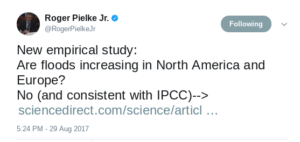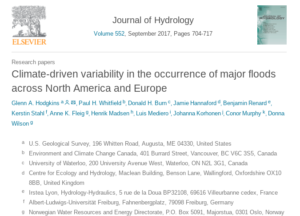#
Journal of Hydrology
Volume 552, September 2017, Pages 704-717
“Climate-driven variability in the occurrence of major floods across North America and Europe”
Highlights
•
Trends in major-floods from 1204 sites in North America and Europe are assessed.
•
Trends based on counting exceedances of flood thresholds for groups of gauges.
•
The number of significant trends was about the number expected due to chance alone.
•
Changes in the frequency of major floods are dominated by multidecadal variability.
Abstract
Concern over the potential impact of anthropogenic climate change on flooding has led to a proliferation of studies examining past flood trends. Many studies have analysed annual-maximum flow trends but few have quantified changes in major (25–100 year return period) floods, i.e. those that have the greatest societal impacts. Existing major-flood studies used a limited number of very large catchments affected to varying degrees by alterations such as reservoirs and urbanisation. In the current study, trends in major-flood occurrence from 1961 to 2010 and from 1931 to 2010 were assessed using a very large dataset (>1200 gauges) of diverse catchments from North America and Europe; only minimally altered catchments were used, to focus on climate-driven changes rather than changes due to catchment alterations. Trend testing of major floods was based on counting the number of exceedances of a given flood threshold within a group of gauges. Evidence for significant trends varied between groups of gauges that were defined by catchment size, location, climate, flood threshold and period of record, indicating that generalizations about flood trends across large domains or a diversity of catchment types are ungrounded. Overall, the number of significant trends in major-flood occurrence across North America and Europe was approximately the number expected due to chance alone. Changes over time in the occurrence of major floods were dominated by multidecadal variability rather than by long-term trends. There were more than three times as many significant relationships between major-flood occurrence and the Atlantic Multidecadal Oscillation than significant long-term trends.
…
Moreover, many studies have not separated the effects of human catchment alterations from those of climate (Burn et al., 2012; Merz et al., 2012; Harrigan et al., 2014); alterations such as urbanisation have been shown to impact observed flood trends (Vogel et al., 2011). To be informative about climate-driven flood trends, catchments should be relatively free of confounding human influences such as land-use change, diversions, abstractions and reservoir regulation. Thus, networks of minimally altered catchments—so called reference hydrologic networks (RHNs)—have been advocated (Whitfield et al., 2012).
…
The results of this study, for North America and Europe, provide a firmer foundation and support the conclusion of the IPCC (Hartmann et al., 2013) that compelling evidence for increased flooding at a global scale is lacking. Generalizations about climate-driven changes in floods across large domains or diverse catchment types that are based upon small samples of catchments or short periods of record are ungrounded.
#
Related Links:
Floods: ‘Floods are not increasing’: Dr. Roger Pielke Jr. slams ‘global warming’ link to floods & extreme weather – How does media ‘get away with this?’ – Pielke Jr. on how extreme weather is NOT getting worse: ‘Flood disasters are sharply down. U.S. floods not increasing either.’ “Floods suck when they occur. The good news is U.S. flood damage is sharply down over 70 years,” Pielke explained.
Scientist: ‘There Is No Such Thing As A 1000-Year Flood’ – Climate Statistician Dr. Matt Briggs: Phrases like “100 year rainfalls” or floods or whatever for whatever period of time are awful. They convey an improper idea of uncertainty. The phrase “X year event” is based on inverting the probability of the event; call that probability p. Thus “X year event” is equal to “1/p year event”, where p is the probability the event happens per year. That means a “100 year event” has a probability of 1%, and so on. A “1000 year event” sounds stupendous, and, to most ears, rarer than a 0.1% chance. Anyway, these are all wrong…It’s perfectly correct to make the statements like this: “The last time a flood this size occurred was in 1945.” That statement is not, however, equivalent to (in 2015) “That was a 70 year flood.”
Climatologist Dr. Roy Spencer: South Carolina Flooding is NOT a 1 in 1,000 Year Event – But a once on 1,000 year event? Sorry, but there is no way to determine that…there are simply not enough rainfall statistics over a long enough period of time to establish such a claim…Unfortunately, there seems to be an trend toward classifying events as “1 in 1,000 years”, when there is no way of knowing such things…For some areas the current flood is no doubt a 1 in 100 year event, or even worse. But remember, it is perfectly normal to have a 1 in 100 year event every year…as long as they occur in different locations. That’s how weather records work.
Meteorologist Topper Shutt – WUSA 9 TV: ‘A 500 year flood does not mean that an area will see a flood of that magnitude once in 500 years. It means that in any given year there is a .2% chance of a 500 year flood and likewise a 1% chance every year for a 100 year flood. Think of it like this. If I flip a coin and it lands heads 5 times in a row the 6th time I flip the coin the odds are still 50/50. The odds are always 50/50. There have been ‘100 year’ floods in Houston in 1929, 1935, Allison in 2001 and Ike in 2008. Folks are probably scratching their heads wondering what in the world is going on. There are several explanations. Firstly, the maps drawn to depict these floods were educated guesses. Remember, we are talking about billions of years of climate and usually just a hundred years of actual, observational data. Secondly, urban development reduces the surface of the ground that allows the rain to permeate into the ground. Adding parking lots, more roads and driveways create more runoff. Thirdly, at least in the case of Houston 1000s of homes have been built close to streams, creeks and bayous that should have never been built in the first place. Houston is the fourth largest city in the U.S.’
Climate Depot Note: The media and climate activists love to hype so-called 1 in 100/1000 year extreme weather events. What they do not not explain is that your chance of the winning the lottery is very low, but the chance of someone, somewhere winning the lottery are very high. So the activists essentially hype “lottery winners” of extreme weather events and try to imply these events are increasing and happening everywhere. Lottery and casino ads do the same by showing all the winners and implying you are just one ticket or spin away from joining the lucky winners. Climate activists are trying to scare the public into believing that they are one bad weather event away from doom and only EPA and the UN Paris climate pact can save them!
Feds declare no climate link to floods in 2015 – South Carolina’s ‘1000 year flood’ only a 10 year flood! U.S. Geological Survey: ‘No linkage between flooding & increase in GHGs’ – Dr. Robert Holmes, USGS National Flood Hazard Coordinator: ‘The data shows no systematic increases in flooding through time’ – ‘USGS research has shown no linkage between flooding (either increases or decreases) and the increase in greenhouse gases. Essentially, from USGS long-term streamgage data for sites across the country with no regulation or other changes to the watershed that could influence the streamflow, the data shows no systematic increases in flooding through time.’ 1000 year flood? ‘The majority of USGS streamgages had flood peaks that were less than 10-year floods.’ – ‘Analysis show NO indication that a 1000-year flood discharge occurred at any USGS streamgages’




